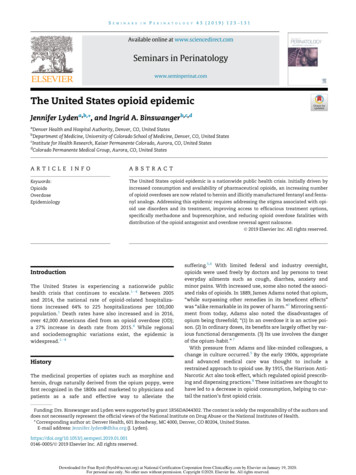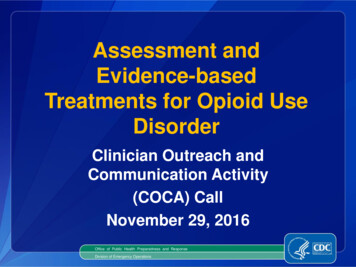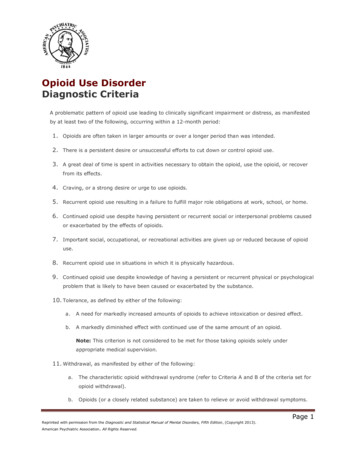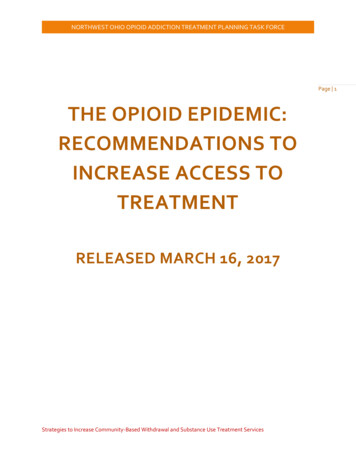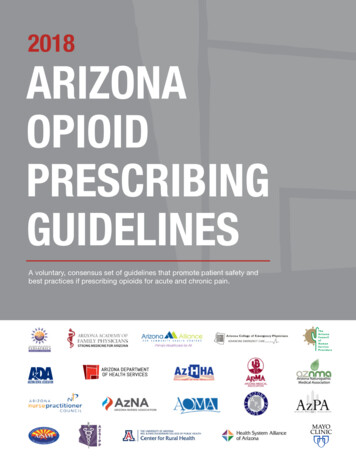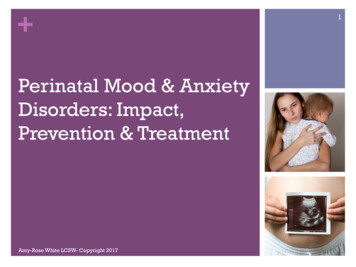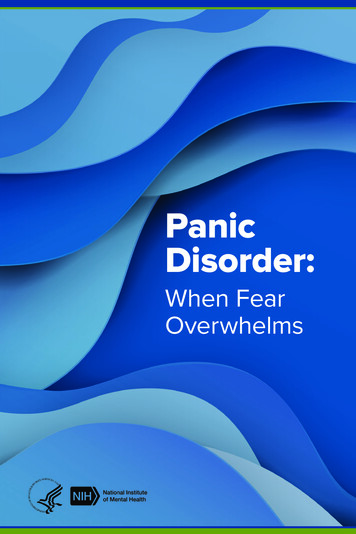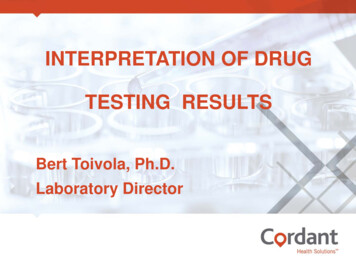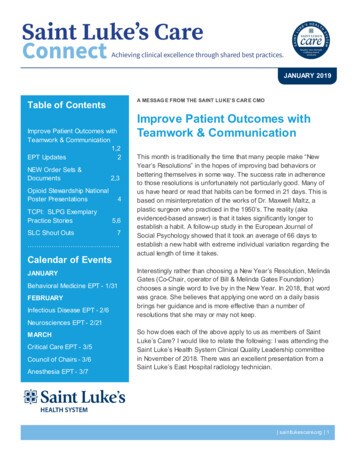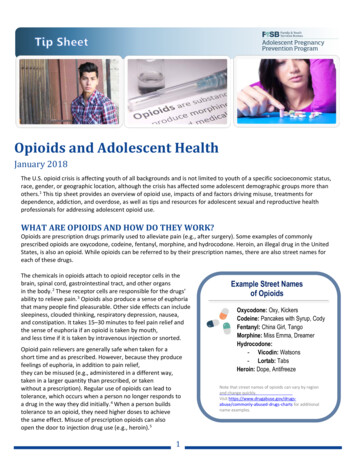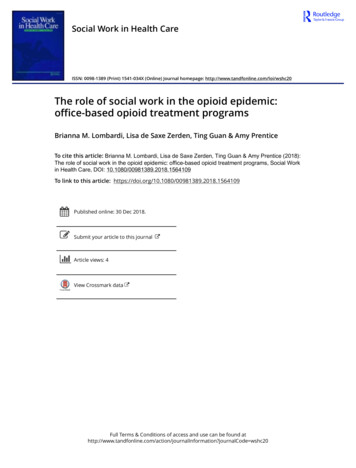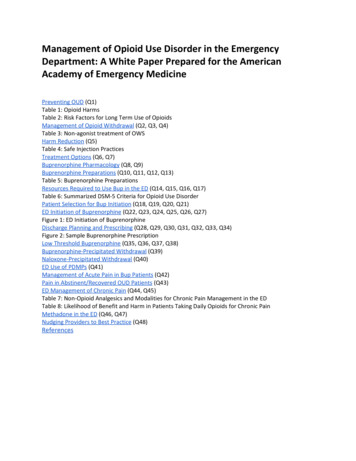
Transcription
Management of Opioid Use Disorder in the EmergencyDepartment: A White Paper Prepared for the AmericanAcademy of Emergency MedicinePreventing OUD (Q1)Table 1: Opioid HarmsTable 2: Risk Factors for Long Term Use of OpioidsManagement of Opioid Withdrawal (Q2, Q3, Q4)Table 3: Non-agonist treatment of OWSHarm Reduction (Q5)Table 4: Safe Injection PracticesTreatment Options (Q6, Q7)Buprenorphine Pharmacology (Q8, Q9)Buprenorphine Preparations (Q10, Q11, Q12, Q13)Table 5: Buprenorphine PreparationsResources Required to Use Bup in the ED (Q14, Q15, Q16, Q17)Table 6: Summarized DSM-5 Criteria for Opioid Use DisorderPatient Selection for Bup Initiation (Q18, Q19, Q20, Q21)ED Initiation of Buprenorphine (Q22, Q23, Q24, Q25, Q26, Q27)Figure 1: ED Initiation of BuprenorphineDischarge Planning and Prescribing (Q28, Q29, Q30, Q31, Q32, Q33, Q34)Figure 2: Sample Buprenorphine PrescriptionLow Threshold Buprenorphine (Q35, Q36, Q37, Q38)Buprenorphine-Precipitated Withdrawal (Q39)Naloxone-Precipitated Withdrawal (Q40)ED Use of PDMPs (Q41)Management of Acute Pain in Bup Patients (Q42)Pain in Abstinent/Recovered OUD Patients (Q43)ED Management of Chronic Pain (Q44, Q45)Table 7: Non-Opioid Analgesics and Modalities for Chronic Pain Management in the EDTable 8: Likelihood of Benefit and Harm in Patients Taking Daily Opioids for Chronic PainMethadone in the ED (Q46, Q47)Nudging Providers to Best Practice (Q48)References
Reuben J. Strayer, MDDepartment of Emergency MedicineMaimonides Medical CenterBrooklyn, NYKathryn Hawk, MD, MHSDepartment of Emergency MedicineYale School of MedicineNew Haven, CTBryan D. Hayes, PharmDDepartment of Emergency MedicineDepartment of PharmacyHarvard Medical SchoolMassachusetts General HospitalBoston, MAAndrew A. Herring, MDDepartment of Emergency MedicineUniversity of California at San FranciscoHighland Hospital-Alameda Health SystemOakland, CAEric Ketcham, MD, MBADepartment of Emergency MedicineDepartment of Behavioral Health, Addiction MedicinePresbyterian Healthcare SystemSanta Fe & Espanola, NMAlexis M. LaPietra, DODepartment of Emergency MedicineSaint Joseph's Regional Medical CenterPaterson, NJJoshua J. Lynch, DOJacobs School of Medicine and Biomedical SciencesDepartment of Emergency MedicineUniversity of BuffaloBuffalo, NYSergey Motov, MDDepartment of Emergency MedicineMaimonides Medical CenterBrooklyn, NYZachary Repanshek, MDDepartment of Emergency MedicineLewis Katz School of Medicine, Temple UniversityPhiladelphia, PAScott G. Weiner, MD, MPHDepartment of Emergency MedicineBrigham and Women's HospitalHarvard Medical SchoolBoston, MALewis S. Nelson, MDDepartment of Emergency MedicineRutgers New Jersey Medical SchoolNewark, NJ
IntroductionOver 2 million Americans misuse prescription or illicitly-obtained opioids, and opioid overdosedeaths rose to a record 47,600 in 2017, representing a nearly 600% increase in 18 years. (NCHS2019, NIH 2019) Because patients with opioid use disorder (OUD) are often socioeconomicallyand functionally marginalized, the primary point of contact with healthcare for many is theemergency department (ED). Emergency clinicians are therefore ideally positioned to addressthe current opioid addiction and overdose epidemic by preventing the development of OUD,identifying patients affected by OUD, and initiating the most effective treatments and harmreduction practices.As the scope of the epidemic has broadened, a crucial shift in therapeutic strategy hasoccurred: whereas people with OUD were commonly referred to detoxification programs andthe use of medication to treat addiction was largely confined to specialist-run clinics, there isnow broad consensus discouraging abstinence-based therapy, which usually results indangerous relapse, in favor of medication-centered treatment initiated at any point of patientcontact. (Srivastava 2017, SMartin 2018, AMartin 2018, D’Onofrio 2018, ACMT 2019, Samet2018, Raheemullah 2019, Blanco 2019, Saloner 2018, Volkow 2018, Wakeman 2018)Most currently practicing emergency clinicians were not trained to initiate medication foraddiction treatment (MAT), also known as medication-assisted therapy, medications for opioiduse disorder (MOUD), opioid agonist treatment (OAT) or opioid substitution treatment (OST).This guideline aims to provide evidence-based recommendations for providers in acute caresettings managing patients being harmed-or at risk to be harmed-by opioids.Q1. How can emergency clinicians prevent the development of opioid use disorder inopioid-naive patients who present with acute pain?Emergency clinicians are charged with providing effective pain relief for opioid-naive patientspresenting to the ED with a variety of acutely painful conditions while managing the potentialfor analgesics to cause harm.For opioid-naive patients who present to the ED with moderate or severe acute pain, opioidsmay be appropriately administered as part of a multi-modal analgesic strategy tailored to thepatient and painful condition.Emergency clinicians’ prescriptions are a comparatively small contribution to overall opioidprescribing in the US. (Weiner 2018) However, ED-based opioid prescriptions may have adisproportionate impact on the development of long-term use because an opioid prescriptionarising from the ED is more likely to be the patient’s first opioid prescription. Even short coursesof opioid therapy are associated with dependence, with one study showing 6% of patients still
filling opioid prescriptions one year after an initial 3-day prescription (Shah 2017), among a hostof corroborating literature demonstrating the link between the first prescription for pain andlong-term use. (Alam 2012, Barnett 2017, Beaudoin 2016, Brat 2018, Calcaterra 2015, Delgado2018, Deyo 2017, Harbaugh 2018, Hoppe 2015, Johnson 2016, Schroeder 2018) Therefore,emergency clinicians should carefully evaluate the potential benefit and harm whenever anopioid prescription is considered, recognizing that preventing long term use centers on keepingopioid naive patients opioid naive. (Nelson 2015, Strayer 2017)Opioids cause a spectrum of harms ranging from the discomfort of mild nausea and pruritis tothe devastating consequences of misuse, overdose, and addiction. ( Table 1 ) The likelihood andimportance of these harms, as applied to a particular patient, should be weighed against theexpected analgesic benefit of an opioid added to effective non-pharmacologic and non-opioidanalgesic modalities. The decision to prescribe outpatient opioids should follow from adiscussion of these benefits and harms with the patient and take into account known riskfactors for opioid misuse, recognizing that many patients without risk factors still developharmful long-term use. ( Table 2 )Table 1: Opioid HarmsConstipation, nausea, itchingDysphoria, confusion, falls, occupational dysfunction, automobile crashesLethargy and respiratory depressionImmunosuppression, hypogonadismOpioid-induced hyperalgesiaOpioid misuse, overdose, addictionDiversion and unintentional ingestion by childrenTable 2: Risk Factors for Long Term Use of OpioidsExisting substance use (including alcohol and tobacco)Psychiatric diseaseSocial isolation, disabilityAdolescents and young adultsThe development of long-term use correlates linearly with the number of days supply of thefirst prescription. (Shah 2017) Therefore, if an outpatient opioid prescription is judged to benecessary and appropriate, the most important strategy to mitigate the risk of misuse is toprescribe a small number of tablets (usually no more than three days’ worth, or 9-12 tabs).Hydrocodone and oxycodone, despite their prevalence, are more euphoric than other opioids(Wightman 2012, Cicero 2013) and the most frequently prescribed preparations are combinedwith acetaminophen. Not only does this co-formulation limit the dose of acetaminophen, aneffective analgesic, but it also introduces the risk of acetaminophen-induced hepatotoxicity ifthe total daily dose of acetaminophen exceeds 4 grams. Immediate-release morphine sulfatetablets are effective and likely less abuse-prone than the aforementioned alternatives.
Extended-release and long-acting opioid preparations should not be prescribed by acute careproviders except under unusual circumstances. (Dowell 2016, Miller 2015) Codeine andtramadol are burdened by a host of unique drug interactions and toxicities and are also bestavoided. (Gasche 2004, Tobias 2016, Young 2013, Nelson 2015)Emergency clinicians should avoid prescribing opioids for painful syndromes commonlyassociated with opioid misuse such as back pain (Krebs 2018), dental pain (Dionne 2016, Patel2018), and headache. (Levin 2014, Franklin 2014)Emergency clinicians who discharge patients with an opioid prescription must discuss safehousehold storage and disposal of unused pills, especially if the patient lives with children oradolescents. Opioids (and all medications) should be stored in their original package, optimallywithin a locked container, out of the reach of children. Unneeded opioids should be disposed ofat a DEA-approved controlled substance public disposal location (many pharmacies and policestations participate–listings can be found on the DEA website (DEA). If a take-back or disposalprogram is unavailable or inconvenient, high-risk substances such as opioids should be disposedof in household trash after mixing with an unpalatable substance and placed in a sealedcontainer, or, specifically in the case of opioids, flushed down the toilet. (FDA 2018)Q2. What is opioid withdrawal syndrome?*Opioid withdrawal syndrome (OWS) is a constellation of signs and symptoms experienced bythose with opioid dependence whose mu-opioid receptors are left vacant from the cessation ofexposure to opioids. The effects associated with OWS are typically extremely uncomfortableand very distressing.Signs and symptoms of OWS include anxiety and irritability, gastrointestinal distress includingabdominal cramping, vomiting and diarrhea, and diffuse somatic pain that ranges from mildlydistressing to unbearable. OWS often includes dysphoria, depression, and hopelessness thatmakes the condition particularly difficult to tolerate. Physical findings may include mydriasis,piloerection, diaphoresis, and yawning, along with typically minor signs of autonomic excess(e.g., hypertension, tachycardia). An intense craving for opioids often makes it difficult for thesepatients to cooperate with medical care, but patients should have a normal mental status.Classically, OWS is not considered life-threatening, but dangerous consequences can be causedby hyperadrenergic tone, particularly in older or frail patients, and especially when OWS isprecipitated by naloxone or buprenorphine. (Wightman 2018, Surmaitis 2018) Patients withOWS are most at risk, however, if their withdrawal symptoms are not adequately treated, asthey are likely to self-treat with dangerous illicitly-obtained opioids, exposing themselves tooverdose and other harms. Patients with opioid dependence often have concomitant medicalillness requiring treatment that they may refuse if their OWS is not alleviated.*Q2, Q3, and Q4 cover abstinence-related opioid withdrawal. For OWS precipitated bynaloxone or buprenorphine, refer to the relevant sections below.
Q3. Should patients with opioid withdrawal be treated with opioid agonist therapies ornon-agonist therapies?Opioid agonist therapy (OAT) should be the first line treatment for patients with OWS in the ED.OAT, as compared to therapies that do not utilize opioid agonists, treats the underlying etiologyof the OWS, manages the symptoms of OWS much more quickly and effectively, and can becontinued long term, which allows the immediate transition from withdrawal to sustainableaddiction treatment.In some settings, OAT may not be available or a patient may not be amenable to OAT. In thesecases, OWS should be treated with medications that are not opioid agonists.Q4. How is OWS treated with agonists and/or non-agonists?Agonist treatment of OWS is best initiated in the ED using buprenorphine or methadone.Buprenorphine is preferred for most patients given its safety benefits compared to methadone( Q8 ). Treatment of OWS with buprenorphine in the ED is equivalent to initiation ofbuprenorphine as a treatment for OUD ( Q19 ). Methadone should be used to treat OWS ifbuprenorphine is not available or in patients withdrawing from methadone (especially if theyplan to return to methadone therapy). Most patients will have significant relief of OWS with 20mg PO methadone or if the patient is vomiting, 10 mg IM methadone ( Q46 ). (Su 2018)In scenarios where OAT cannot be utilized, either due to availability or patient preference,treatment should be tailored to the patient’s symptoms. ( Table 3 ) Agitation can be treated withantipsychotics, antihistamines, and/or benzodiazepines. Gastrointestinal effects can be treatedwith antiemetics, antidiarrheal agents, and antispasmodics, while dyspepsia can be treated withH2 antagonists. Severe pain related to OWS is unlikely to be alleviated by acetaminophen orNSAIDs, although there is little downside to trying these medications. Ketamine, haloperidol,and baclofen are non-opioid medications that may provide analgesia. Autonomic dysfunctionthat leads to many of the findings of OWS, such as hypertension, diaphoresis, irritability, andrestlessness, may be treated with alpha-2 agonists; clonidine has been the traditionalmedication used from this class. Lofexidine has recently been FDA approved for treatment ofOWS and may provide marginally better symptomatic relief with fewer side effects comparedto clonidine, but is dramatically more expensive. (Juurlink 2019)Table 3: Non-agonist treatment of OWSDysautonomiaclonidine 0.1 mg po q1-3hdexmedetomidine start at 0.2 mcg/kg/minlofexidine 0.2-0.4 mg po q6-12h
Painibuprofen 400-600 mg po q4-6hketorolac 10-15 mg IV/IM q4-6hacetaminophen 500-1000 mg po q4h up to 4 gm dailygabapentin 200-400 mg po q6-8hbaclofen 10 mg po q8htizanidine 4-8 mg po q6-8hGI Distressondansetron 4-8 mg po/IV q4-6hpromethazine 25-50 mg IV/IMmetoclopramide 10-20 mg IV q6-8hdiphenhydramine 50 mg IV q6-8hhydroxyzine 50-100 mg po/IM q4-6hloperamide 4 mg po q4hdicyclomine 20 mg po q6hAgitationlorazepam 2-4 mg PO/IV q2-4hdiazepam 10-20 mg IV q30-60 minmidazolam 2-5 mg IM/IV q2hhaloperidol 2-10 mg IV/IM/PO q4-6hdroperidol 1-5 mg IV/IM q4-6holanzapine 5-10 mg IM q4hziprasidone 10-20 mg IM q4hketamine 0.25 mg/kg IV over 20 min q2hQ5. How can emergency clinicians protect the health of OUD patients apart from initiatingbuprenorphine?Harm reduction is a public health-based strategy to reduce the negative consequencesassociated with a particular disease or behavior for individuals and their communities. Althoughit is most often associated with drug use, it also applies to clinicians’ attempts to manageconditions such as diabetes and hypertension, with the goal of encouraging individuals to be ashealthy as possible by meeting patients where they are –even if they don’t follow the optimaltreatment plan–through teaching the skills necessary to maximize quality of life and minimizemorbidity.Emergency departments increasingly care for patients following opioid overdose, who have a1-year mortality of over 5%, (Vivolo-Kantor 2018, Weiner 2019). Harm reduction, as it pertainsto OUD, promotes health both for patients who are ready to move to recovery (withmedications and treatment engagement) and those who are not, by providing access to
knowledge and resources to keep the patient as healthy as possible, recognizing that the doorto recovery remains open as long as the patient is alive.Overdose prevention and naloxone distribution, initiated in the late 1990s by harm reductionorganizations, is recognized as an important healthcare intervention for high-risk patients.Naloxone distribution has received wide support from many federal and national organizationsincluding the US surgeon general, who in April 2018 released an advisory encouraging the widedistribution of naloxone to individuals who use opioids, as well as to their friends and families.(Hawk 2015, Adams 2018, Samuels 2016) Clinicians may be concerned about the possibility ofincreased risky opioid use if naloxone is available in the community. Evidence does not suggestthat this parachute effect o ccurs significantly, and to the extent it does occur, it is likelyoutweighed by the public health benefits from overdose rescue. Limited evidencedemonstrates opioid use is decreased or unchanged where naloxone distribution occurs, (Seal2005, Wagner 2010) and we recommend ED-based naloxone distribution as further research isongoing. Localities with high naloxone dissemination have lower opioid-related mortality,(Walley 2013) and people who have been rescued from overdose may be particularly receptiveto addiction treatment. PrescribeToPrevent.org provides emergency department-specificguidance on naloxone preparations, prescribing and billing, patient instructions, and sampleprotocols.Emergency clinicians can reduce morbidity and mortality in people with ongoing opioid use byoffering screening for pregnancy, Hepatitis C and HIV, and with frank discussions around safeinjection practices. ( Table 4 ) Many municipalities offer syringe service programs that not onlyreduce the devastating consequences of contaminated needle use (Aspinall 2014, Kaiser 2019)but are often integrated with social work, case management, and treatment referral servicesthat can improve patient outcomes. Limited data indicate that these programs, along withsupervised consumption sites, reduce the dangers of illicit substance use as well as thecommunity harms of public injecting and unsafely disposed syringes, without increasing druguse, trafficking, or crime. (CDC 2019, HHS 2011, Kishor 2019, Gostin 2019, AMA 2017)Table 4: Safe Injection Practices (NYC DOH 2019)Avoid using alone . If you overdose, you want someone around to help.Be cautious if you haven’t used in a while . You’re more likely to overdose.Avoid mixing . Many overdoses happen when heroin or painkillers are mixedwith other drugs like benzos, methadone, antidepressants, and/or alcohol.Always do a tester shot to make sure a new batch isn’t too strong .Make an overdose plan . Be prepared with naloxone, and have a phone on hand in caseyou need to call 911.Don’t be afraid to call 911 . If you’re with someone who you think is overdosing, call 911.The law provides substantial protection from prosecution.Always use new equipment, and never share equipment . Many communities anonymouslyprovide free syringes and drug use equipment.Never lick needles , always use sterile water , and discard cotton after every use.
Q6. What is the relative efficacy of MAT compared to abstinence-based treatment programs inreducing morbidity and mortality in patients with opioid use disorder?Stigma and bias among clinicians, the public, payors, policy-makers, and even the patientsthemselves toward people with substance use disorder has led to acceptance of theabstinence-based treatment standard historically adopted for this disease. While this approach(which includes most “detox,” “rehab” and 12-step programs) may be valid for certainsubstance use disorders, such as stimulants, the availability of mechanism-based andevidence-based pharmacologic agents strongly differentiates the treatment of OUD. The stigmais often manifest in the misguided belief that the use of buprenorphine or methadone is“replacing one addiction with another.” Buprenorphine or methadone therapy uses one opioid(that is pharmaceutical and legal) to replace another (that may not be either); even thisdescription of MAT undervalues its personal and societal benefits, however. Addiction is a DSM5-defined diagnosis that is distinguished from dependence fundamentally by behavior, andeffective treatments reduce the harmful behaviors associated with drug use that can havesignificant health, work, family and legal consequences. Buprenorphine or methadonetreatment reduces or eliminates harms arising from the desperate behavior caused by the fearof running out of opioids and developing withdrawal, as well as the harms associated with usingand especially injecting chemicals purchased on the street of uncertain identity and potency.Because there are several widely varying forms of behavioral therapy there is confusion in theliterature and little consistency in treatment practices. (Dugosh 2016) Behavioral therapy alonewithout an agonist (i.e., detoxification) is not generally effective in maintaining abstinence.(Sofuoglu, Amato) Though the addition of behavioral therapy to an opioid agonist may improveretention in long-term treatment, counseling does not convey significant added value inshort-term morbidity or mortality. (Sufuoglu, Amato) Therefore, providers should not link theinitiation of MAT to the immediate availability of or patient willingness to participate incounseling. Furthermore, patients who request detoxification treatment (often originating froma stigma-based desire to be “drug-free”) should be advised of the much higher likelihood ofrelapse when treatment does not include the use of opioid agonists. Additionally, especially at atime when the street opioid supply has been contaminated with illicit fentanyl and itsanalogues, patients should be educated about how dangerous relapse is. These conversationsmay frame buprenorphine as a treatment for addiction similar to insulin as a treatment fordiabetes.United States federal law requires that patients being treated with MAT receive behavioralcounseling, however emergency clinicians meet this requirement by referring thebuprenorphine-initiated patient to outpatient addiction care. (SAMHSA 2019)Q7. How do naltrexone, methadone, and buprenorphine compare as treatments for opioid usedisorder?
There are limited head-to-head comparisons on the safety or effectiveness of these threeevidence-based pharmacological approaches to managing patients with OUD. (Mattick 2014,Morgan 2019) However, the data on each are sufficiently robust to draw conclusions on theircomparative effectiveness and specifically on their practical utility in the management ofpatients in the ED.Naltrexone, a long acting opioid receptor antagonist, competitively inhibits the agonist effectsof opioid agonists. It is most commonly administered for OUD treatment in its intramusculardepot formulation which provides effective antagonism for about one month; however, as acompetitive antagonist, the use of high doses of potent opioids can overcome this blockade.Unlike agonist therapies, naltrexone does not address the altered neurochemistry that causesopioid cravings and relapse. Patients must have not taken opioids for several days prior toadministration to prevent the development of precipitated opioid withdrawal; this creates asignificant barrier to initiation, as withdrawal is what many OUD patients want desperately toavoid, and essentially eliminates its use in the ED setting.Buprenorphine and methadone are long-acting opioid agonists with a significantpharmacological distinction: methadone is a full opioid receptor agonist and buprenorphine is apartial opioid receptor agonist ( Q8 ). Both are effective at treating opioid withdrawal and atreducing opioid use and harm. (Larochelle 2018, Mattick 2014, Morgan 2019, Pierce 2016,Sordo 2017, Weiss 2017) Methadone, as a full agonist, is significantly more prone to abuse thanbuprenorphine and is far more dangerous in overdose. Methadone also provides less opioidreceptor “blockade” effect compared to buprenorphine; receptor blockade protects patientsagainst overdose with other opioids.Buprenorphine and methadone are also distinguished by their regulatory status. Methadonefor the treatment of OUD can only be dispensed (not prescribed) through federally-regulatedopioid treatment programs (OTPs); initiating methadone as a treatment for addiction istherefore not possible from the ED. Buprenorphine may be prescribed by any provider with aDATA 2000 waiver and administered in the ED for 72 hours by waivered or non-waiveredclinicians, making it significantly more accessible and relevant to emergency care ( Q15 ).Q8. What are the pharmacologic features of buprenorphine that make it well-suited to treatopioid use disorder?Buprenorphine is a mu-opioid receptor partial agonist that binds with a higher affinity t hannearly every other opioid and dissociates slowly. Due to the partial agonism, binding to theopioid receptor evokes only limited clinical effects, and as the dose is escalated a maximalresponse is reached, a ceiling effect . Even at high doses in opioid naive patients, respiratorydepression and euphoria are minimal compared to that from full opioid agonists. (Coe 2018)
In patients with abstinence-induced opioid withdrawal, buprenorphine’s partial agonism isgenerally sufficient to replace the loss of agonism as the concentrations of full agonist fall,quelling the clinical manifestations of withdrawal.Due to the high mu-opioid receptor binding affinity of buprenorphine, full agonist opioids havelimited ability to displace the buprenorphine. This explains why administration of a full agonistopioid, such as heroin, after buprenorphine results in reduced clinical effect, often referred toas buprenorphine blockade . (Jasinski 1978) This opioid receptor blockade protectsbuprenorphine-using patients from overdose and limits euphoria and reward from full agonists,though buprenorphine blockade can be partially overcome with high doses of full agonists. Italso highlights the difficulty in using opioids to manage acute pain in a patient onbuprenorphine maintenance treatment.Buprenorphine exhibits slow dissociation from the opioid receptor and a long eliminationhalf-life, allowing buprenorphine to be dosed once per day or even less frequently, (Coe 2018)though BID or TID dosing is sometimes used, especially early in buprenorphine therapy.Q9. What are the important harms associated with buprenorphine use and buprenorphineabuse?In opioid-dependent patients who are not in withdrawal, administration of buprenorphine mayresult in precipitated opioid withdrawal because a partial agonist (buprenorphine) displaces thefull agonist (heroin, for example) from the receptor. Initiating buprenorphine treatmenttherefore requires that the patient already be sufficiently in withdrawal, or past the period ofphysical withdrawal, to avoid buprenorphine-precipitated withdrawal.Buprenorphine administered by the intravenous route is more psychoactive and rewardingthan by the proper, sublingual route. (Huestis 2002) To prevent surreptitiousself-administration of intravenous buprenorphine, the preferred outpatient formulationcontains naloxone. ( Q11 ) When opioid-dependent patients use buprenorphine/naloxoneformulations by the sublingual route prior to the development of moderate withdrawal,precipitated opioid withdrawal may occur due to the buprenorphine, not due to the naloxone.In opioid naïve adults or especially children, at very high doses (relative to body weight), thepartial agonism may still cause clinically consequential adverse opioid effects, includingdangerous respiratory depression, especially when used with other sedating medications suchas benzodiazepines. (Seldén 2012, Kriikku 2008, Hayes 2008) Despite the potential risk,buprenorphine is substantially safer than any of the full agonist opioids.Buprenorphine, as with other opioids, induces hyperalgesia, in which the sensitivity to painfulstimuli increases with ongoing opioid exposure. (Athanasos 2019)
Q10. Which immediate release buprenorphine preparations are commonly used in acute caresettings to treat opioid use disorder?Buprenorphine is available in several formulations, some in combination with naloxone. ( Table5 ) The most commonly used preparations in the ED are sublingual film and sublingual tablets;clinically, there is little difference in effects or patient-oriented outcomes between them, norbetween sublingual preparations and the less commonly used buccal preparations. ( Gunderson2015, Gunderson 2016 , Sullivan 2015) Lower-dose preparations (Belbuca, Butrans) areindicated for pain, not OUD treatment.Buprenorphine is also available in an intravenous form, as a 0.3 mg/mL solution for injection.This formulation is only FDA-approved for acute pain management, but can be used for opioidwithdrawal when vomiting interferes with sublingual administration. Access to intravenousbuprenorphine is not required, however, as sublingual administration is almost always effectiveeven in the setting of vomiting.Table 5: Buprenorphine Preparations (Lexicomp 2019)Dosage FormTradeName(s)Medication(s)Available Dose(s)ApproximatePrice per DoseBuccal FilmBelbucaBuprenorphine 6-15BunavailBuprenorphine/naloxone75 mcg, 150 mcg, 300mcg, 450 mcg, 600mcg, 750 mcg, 900mcg2.1/0.3 mg, 4.2/0.7mg, 6.3/1 mgSuboxoneBuprenorphine/naloxone2/0.5 mg, 4/1 mg, 8/2mg, 12/3 mg2/0.5 mg, 8/2 mg 5-200.7/0.18 mg, 1.4/0.36mg, 2.9/0.71 mg,5.7/1.4 mg, 8.6/2.1mg, 11.4/2.9 mg2/0.5 mg, 8/2 mg 5-202 mg, 8 mg prenorphineGeneric 9-18 4-9 4-10SubcutaneousImplantProbuphineImplant KitBuprenorphine74.2 mg 1,500TransdermalPatch(Weekly)ButransBuprenorphine5 mcg/hr, 7.5 mcg/hr,10 mcg/hr, 15 mcg/hr,20 mcg/hr 80-215
GenericBuprenorphine5 mcg/hr, 7.5 mcg/hr,10 mcg/hr, 15 mcg/hr,20 mcg/hr 65-170Solution ine0.3 mg/mL (1 mL)0.3 mg/mL (1 mL) 18 ne100 mg/0.5 mL (0.5mL), 300 mg/1.5 mL(1.5 mL) 1,200-1,900Prices based on estimated Average Wholesale PriceQ11. What are the roles for buprenorphine mono-product and the combination product withnaloxone?Naloxone is added to some products as an abuse-deterrent. Naloxone’s bioavailability via oral,sublingual, and buccal r
University of California at San Francisco Highland Hospital-Alameda Health System Oakland, CA Eric Ketcham, MD, MBA Department of Emergency Medicine Department of Behavioral Health, Addiction Medicine . mg PO methadone or if the patient is vomiting, 10 mg IM methadone ( Q46 ). (Su 2018)
